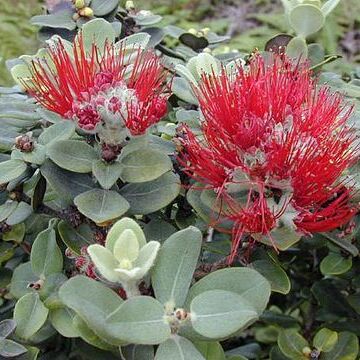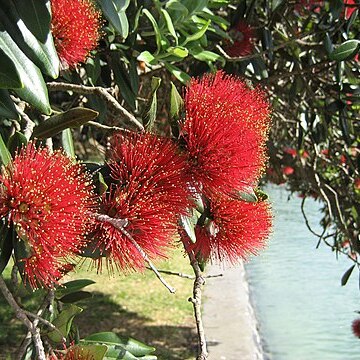Trees, shrubs or lianes, sometimes epiphytic, often with bud scales. Leaves simple, opposite, petiolate. Inflorescence axillary or terminal, pedunculate, cymose, often compound, sometimes reduced to a single flower. Flowers (re. petals, filaments, style) red, crimson, pink or white, rarely yellow or orange. Hypanthium extending on top of ovary. Sepals 5, equal, free. Petals 5, oblong to orbicular, often caducous. Stamens numerous, 3 or more times as many as petals, usually in a single series, free, much longer than petals. Ovary semi-inferior to ± superior (semi-inferior to inferior, fide Messina 2016), usually 3-locular; ovules numerous, axile. Fruit a loculicidal capsule, coriaceous to woody, included in, or exserted from the hypanthium, sometimes with development of tissue between, and separating, style base and placentas. Seeds numerous, linear or filiform, many infertile.
More
Fls in us. terminal cymes or racemes; receptacle adnate to ovary; sepals 5, imbricate; petals 5; stamens ∞, much > petals; filaments filiform, anthers versatile. Ovary 3-celled, style filiform, ovules ∞. Capsules coriac., loculicidally 3-valved, or dehiscence irregular; seeds linear. Aromatic shrubs, trees or woody lianes with simple, opp., gland-dotted, exstipulate lvs. Some 20 spp. of N.Z., Australia, Polynesia to Malaya―the N.Z. spp. endemic.
In Australia a number of introduced Metrosideros species (often referred to as New Zealand Christmas Bush), including cultivars with variegated foliage, are cultivated in gardens as ornamental and hedge plants, e.g. M. collina, M. excelsa, M. kermadecensi. See Rodd (1996: 302), Ellison (1999: 386–387), Spencer (2002: 401–402), Dawson & Heenan (2010). Some species are a source of timber, especially in New Zealand (Spencer 2002).


